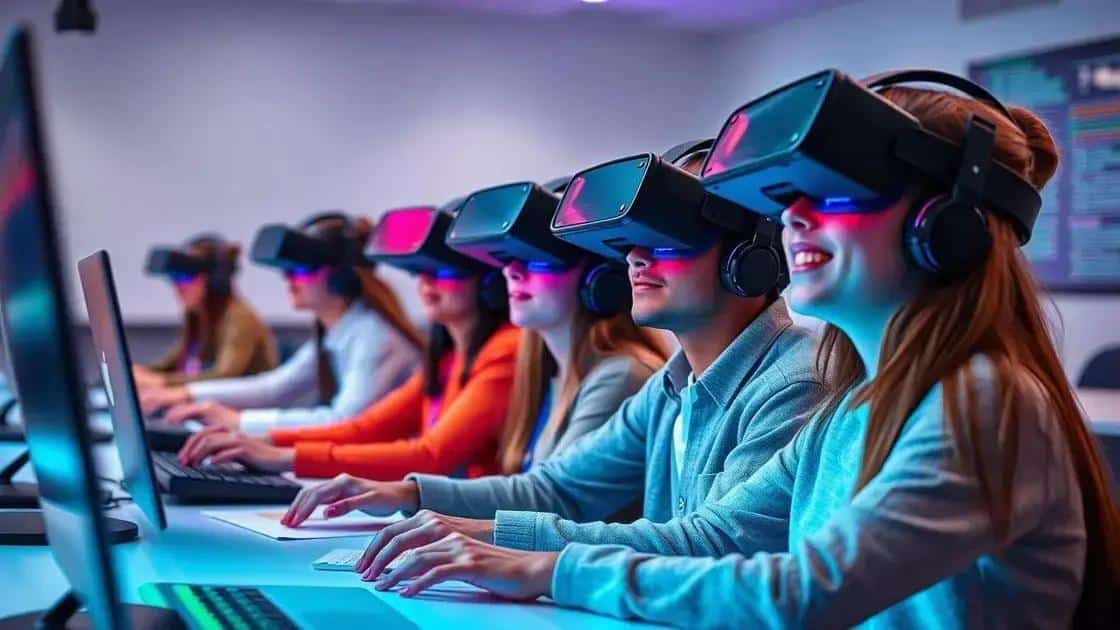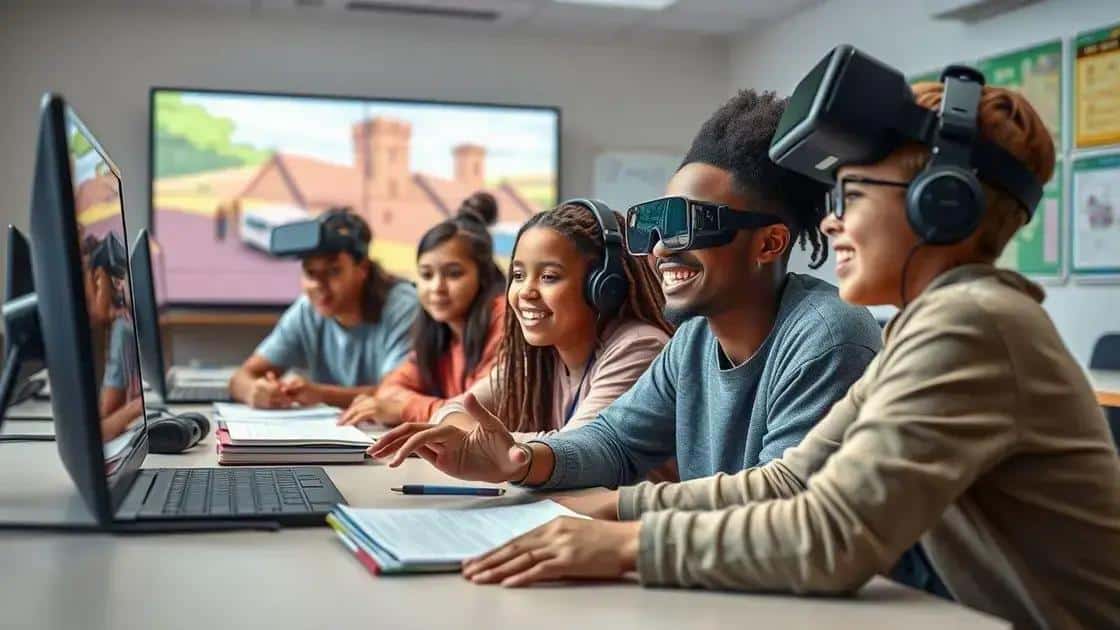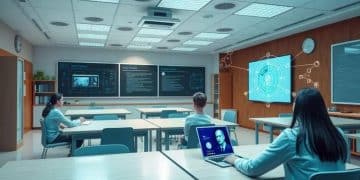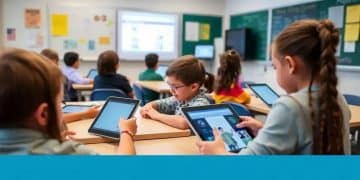Insights on vr learning environments: enhancing education

Insights on VR learning environments show that these innovative tools enhance student engagement, provide personalized learning experiences, and allow for immersive virtual field trips, significantly transforming the educational landscape.
Insights on vr learning environments reveal a growing trend that has the potential to change how we approach education. Have you ever thought about how immersive technology could enhance your learning experience? In this article, we will dive into the benefits and applications of vr in educational settings.
Understanding vr learning environments
Understanding vr learning environments is essential in today’s educational landscape. These innovative spaces are transforming how students learn and interact with content. By using virtual reality, education becomes more immersive and engaging, leading to better retention and comprehension.
The essence of vr learning
A vr learning environment allows students to experience lessons in an interactive manner. Instead of passively absorbing information, students can explore virtual worlds, conduct experiments, and engage in simulations. This hands-on approach enhances understanding and keeps learners motivated.
Key benefits of vr in education
- Increased engagement and motivation among students.
- Enhanced understanding of complex subjects through immersive experiences.
- Opportunities for safe experimentation in a virtual setting.
- Ability to cater to diverse learning styles and needs.
Moreover, in a traditional classroom setting, teachers might struggle to captivate every student’s attention. However, with vr learning environments, many students report feeling more involved in their education. They are not merely observers but active participants in their learning journey.
Additionally, vr technology can help bridge gaps in understanding. For example, a student who might find it challenging to grasp certain scientific principles through textbooks can visualize and interact with these concepts in a virtual space. The level of engagement and curiosity generated by such experiences is incomparable.
Challenges to consider
While vr learning environments offer numerous advantages, there are also challenges to consider. Implementing technology may require significant investment, and not all institutions are equipped to provide these resources. Moreover, teacher training is vital to ensure effective use of vr tools in the classroom.
In conclusion, understanding vr learning environments highlights their potential to revolutionize education. They promise to make learning more engaging, provide practical experiences, and prepare students for a tech-driven future. Educators and institutions should embrace this technology to enhance the academic experience.
The impact of vr on student engagement

The impact of vr on student engagement is profound. Virtual reality creates interactive experiences that grab students’ attention and encourage them to learn actively. With immersive technology, students can visualize concepts in ways that traditional methods cannot achieve.
How vr fosters engagement
One major benefit of vr learning environments is their ability to foster deeper engagement. For instance, students can explore historical sites or conduct science experiments in a safe, controlled setting. When learners can step into new worlds, their curiosity is sparked. This kind of experience can lead to better focus and retention of information.
Elements that enhance engagement
- Interactivity: Students can manipulate objects in real-time.
- Realism: The lifelike simulations make learning feel relevant.
- Personalization: Teachers can tailor experiences to individual learning needs.
- Collaboration: Virtual group activities encourage teamwork.
Moreover, vr technology can help students who struggle in traditional classrooms. It makes learning accessible and engaging for various learning styles. Some students, for example, may excel in a visual and kinesthetic learning environment, which vr provides.
In essence, when students engage with vr content, they can view lessons from multiple perspectives. This diverse approach to learning helps create a more thorough understanding of subjects. People often remember experiences better than facts presented in textbooks alone, which is why vr is particularly effective.
Measuring engagement levels
To assess the impact of vr on student engagement, educators can track various metrics. These may include participation rates during lessons, student feedback on the experience, and improvements in test scores. Many teachers report increased enthusiasm and eagerness to learn when using vr tools.
Ultimately, the impact of vr on engagement illustrates its potential to make learning more enjoyable and effective. As more schools adopt this technology, it’s likely we will see continued improvements in how students connect with educational material.
Best practices for implementing vr in classrooms
Implementing vr in classrooms can be transformative. To maximize its effectiveness, educators should follow some best practices. This approach ensures that both teachers and students benefit from virtual reality technology.
Start with clear goals
Before introducing vr learning environments, it’s crucial to define clear educational goals. Determine what skills or knowledge you want students to gain. Having a focused direction helps guide lesson materials and activities.
Integrate with the curriculum
Integrating vr into existing curricula enhances the learning experience. For instance, if teaching history, consider using vr to take students on a virtual tour of ancient civilizations. This real-world connection makes lessons more engaging and relatable.
Focus on user experience
- Ensure all students are comfortable using vr headsets.
- Select age-appropriate content that aligns with educational standards.
- Provide simple instructions and practice sessions for students.
- Allocate enough time for exploration and interaction within the vr environment.
A well-planned user experience can make students feel more at ease during lessons. Keeping students engaged means they can focus better and learn more effectively. Don’t forget to gather student feedback to adapt and improve the experience.
Additionally, teachers should collaborate with technology specialists to choose the right tools. Assessing available vr resources is important for ensuring the technology aligns with class objectives. Having the right equipment can enhance the overall learning experience.
Encourage Collaboration
Encouraging collaboration among students can further enrich the vr learning environment. Group activities allow students to share their experiences and findings with one another. This teamwork fosters communication skills and builds community in the classroom.
Moreover, creating a safe space for students to express their insights or concerns can lead to a more inclusive learning environment. When students feel heard, they are more likely to participate actively in lessons.
Future trends in virtual reality education

Future trends in virtual reality education are shaping how we think about learning. As technology continues to evolve, vr is becoming more accessible and effective in classrooms. The potential for immersive experiences in education is vast.
Greater Accessibility
One promising trend is the increasing accessibility of vr technology. As costs decrease and devices become more user-friendly, more schools can adopt these tools. This democratization of technology means that students from various backgrounds can benefit from vr learning environments. It also encourages the creation of more diverse educational content.
Personalized Learning Experiences
Another trend is the move towards personalized learning experiences. VR can adapt to individual learning styles and paces. For instance, students who struggle with certain subjects can receive tailored lessons through immersive simulations that focus on their specific needs. This personalization ensures that each student has the opportunity to thrive.
Enhanced Collaboration
- Virtual classrooms allowing students from various locations to learn together.
- Collaboration on projects in a shared vr environment.
- Peer-to-peer learning as students explore together.
- Real-time feedback and support from instructors.
This collaboration can enhance communication skills and deepen understanding of the material. By working together in vr, students can engage in meaningful discussions and share insights.
In addition, integrating ai technology with vr education is a growing trend. AI can analyze student performance and suggest improvements tailored to each learner. This connection between AI and vr will enhance the overall educational experience.
Virtual Field Trips
Lastly, virtual field trips are becoming commonplace in vr classrooms. Instead of a traditional field trip, students can visit historical sites, museums, or even outer space without leaving their classroom. This kind of engagement can ignite curiosity and inspire students in ways that standard lessons cannot.
As we look to the future, it’s clear that vr education is set to expand. The integration of technology, personalization, and collaboration will create engaging and effective learning environments for students worldwide.
In summary, the future of virtual reality education is bright. As technology continues to improve, schools and educators will have more tools to enhance learning. With greater accessibility, personalized experiences, and collaborative opportunities, students can engage in a way that was once unimaginable. Virtual field trips and the integration of AI will also make lessons more exciting and engaging. By embracing these trends, educators can create impactful learning environments that inspire and educate students effectively.
FAQ – Frequently Asked Questions about Virtual Reality in Education
How does virtual reality improve student engagement?
Virtual reality creates immersive experiences that captivate students’ attention, making learning interactive and enjoyable.
What are the key benefits of using VR in the classroom?
Key benefits include increased engagement, personalized learning, and the ability to simulate real-world experiences.
Can VR technology be integrated into existing curricula?
Yes, VR can complement and enhance traditional lessons by providing interactive simulations and virtual field trips.
What challenges should educators be aware of when implementing VR?
Challenges include equipment costs, the need for teacher training, and ensuring all students have access to the technology.





